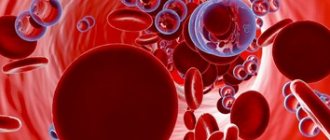- What function do lymphocytes perform?
- Types of lymphocytosis
- Physiological lymphocytosis
- Lymphocytosis in viral diseases
- Lymphocytosis in bacterial infections
- Hematological diseases
- Endocrine system diseases
- Rheumatological, allergic and parasitic diseases
- Diagnosis of lymphocytosis
- Treatment of lymphocytosis
Lymphocytosis is a type of leukocytosis.
This is a condition in which the level of lymphocytes in the blood of an adult exceeds 4000 units, and in children under 5 years of age - 6000 units per microliter. In percentage terms, this ranges from 40% or more for adults and 55% for young children. Normally, the blood of a healthy adult contains 20-40% lymphocytes. Lymphocytosis can occur for physiological and pathological reasons. As a rule, in most cases it is one of the symptoms of the disease. The cause of lymphocytosis can be not only blood diseases, but also viruses, infections, and certain physiological reactions.
To diagnose lymphocytosis, venous or capillary blood is used. Laboratory testing determines the main blood parameters, including the level of lymphocytes.
What function do lymphocytes perform?
These blood cells provide the body's defense against pathogens. Lymphocytes produce immunoglobulins - antibodies that bind to viral infection and thereby prevent it from entering the cells of organs and tissues. Lymphocytes are also part of the mechanism to destroy cells that are already infected with the virus. In a similar way, lymphocytes can fight certain types of bacterial and parasitic infections. Thus, an increase in lymphocytes in the blood is the response of the immune system when an infection enters the body.
Types of lymphocytosis
The disease is divided into relative and absolute types. Relative is characterized by an increase in the number of lymphocytes against the background of normal or reduced levels of leukocytes in the blood.
With absolute lymphocytosis, the level of lymphocytes is exceeded, as is the content of leukocytes.
According to the degree of excess, moderate and high lymphocytosis are distinguished. If the percentage of lymphocytes is below 60%, we are talking about moderate lymphocytosis. When the lymphocyte content is high, it is above 60%, which may be a sign of a malignant hematological disease or diseases of the lymphatic system.
Physiological lymphocytosis
Sometimes an increase in lymphocytes is not associated with a disease and is a natural reaction of the body. The main reasons for this phenomenon are:
- early childhood;
- psycho-emotional stress;
- fasting, avoidance of animal products;
- taking certain medications.
In children under 4-5 years of age, an increased level of lymphocytes is a physiological norm. Already from the first week of life in a newborn, the lymphocyte count reaches 55-60%. This is due to age-related characteristics of the immune system. By 4-5 years, the level of lymphocytes decreases to 40%. If in a small child this figure exceeds 60%, this is a pathology.
As for lymphocytosis during stress, fasting, and taking medications, the change in the leukocyte formula is short-term. The indicators return to normal as soon as the causative factor ceases to affect the body.
What determines the degree of lymphocyte enlargement?
According to popular belief, the severity of the disease can be judged by how much the patient’s tests are changed. In some cases this is true. For example, the severity of jaundice is determined by the content of bilirubin in the blood (the more it is, the more serious the situation), and by the erythrocyte sedimentation rate - the degree of activity of rheumatic diseases. But with lymphocytes everything is not so simple. For example, with the same viral infection they can be normal, elevated, and sometimes it even happens that with ARVI, lymphocytes are reduced.
It is also appropriate to remember that there is such a thing as hyperimmunity. In this case, in response to the slightest irritation, for example to a slight viral runny nose, a huge number of lymphocytes are produced, and the test results terrify the attending physician, who immediately begins to suspect the person has lymphocytic leukemia. But in fact, the nature of such changes is only that the patient’s immunity reacts strongly to any threat.
In general, if a person has elevated lymphocytes, the reasons for this should be determined not by their number, but by their general health, symptoms, data from other studies, and the results of a conversation with a doctor.
If the doctor identifies any disease, the patient needs to follow the proposed treatment regimen in order to quickly bring the level of lymphocytes and general health back to normal. To achieve faster and better results, it is recommended to take Transfer Factor.
– a special tool created on the basis of information molecules. It has a universal training effect on the immune system and normalizes its functioning, regardless of what exactly the person is sick with. Taking the drug gives positive results in the treatment of most diseases.
Lymphocytosis in viral diseases
Diseases caused by viruses are a common cause of lymphocytosis. In adults, it occurs with influenza and acute respiratory infections. In children - with chickenpox, measles, rubella. As a rule, patients are diagnosed with moderate lymphocytosis, which occurs as the symptoms of the disease increase. After recovery, blood counts return to normal.
The exception is infectious mononucleosis caused by the Epstein-Barr virus. The pathogen belongs to the herpevirus family. It multiplies in B lymphocytes and stimulates their growth. Adults and children are susceptible to this disease, but in childhood the risk of getting sick is much higher. In middle-aged and mature people, the pathology occurs without pronounced symptoms, since specific immunity has already been formed.
Against the background of infectious mononucleosis, persistent moderate lymphocytosis is observed. In addition, atypical mononuclear cells are found in the blood - large cells characteristic of the disease.
Lymphocytosis in bacterial infections
Some diseases caused by pathogenic bacteria also result in lymphocytosis. As a rule, we are talking about diseases that have a chronic course. In adults, lymphocytosis is diagnosed against the background of tuberculosis, syphilis, brucellosis, and various forms of typhoid diseases. In children, a similar condition is observed with whooping cough.
Changes in leukocyte counts depend on the nature of the pathology. In the chronic form, there may be a slight or moderate increase in levels that persists for several months or even years. If the disease worsens, the number of lymphocytes increases as symptoms increase.
Causes of lymphocytosis
Physiological conditions
The most striking example is physiological lymphocytosis in children under 4-5 years of age. The reason for this phenomenon is associated with age-related changes in the child’s immune system. From the 7th day of life in children, an active increase in the number of lymphocytes begins (up to 55-60%) and a decrease in neutrophils (the first cross-over of the leukocyte formula). Then, by the age of 4, lymphocytes return to the same levels as in adults (up to 40%), and neutrophils, on the contrary, increase (second crossover). Pathological lymphocytosis in children should be considered figures greater than 60%.
Separately, short-term lymphocytosis is distinguished, not associated with any disease. Among these causes of lymphocytosis:
- Stress
. - Nutritional factors
: fasting, following a vegetarian diet. - Use of medications
: phenytoin, para-aminosalicylic acid, narcotic analgesics.
Viral infections
Lymphocytes are the main “weapon” of the immune system against viruses. They produce special antibodies (immunoglobulins), which, by binding to the virus, prevent its penetration into cells. Subsequently, the viral particles undergo phagocytosis. Another mechanism of antiviral immunity is the destruction of cells infected with viral DNA or RNA by triggering programmed cell death (apoptosis). In a similar way, lymphocytes fight certain bacteria and intracellular parasites (Toxoplasma).
- Acute viral infections
. The most common causes of lymphocytosis in children are infectious diseases such as measles, rubella, and chicken pox; in adults - influenza, ARVI. Typically, lymphocytosis is moderate, it occurs abruptly, reaches a maximum parallel to the height of the disease, then quickly returns to normal values as the symptoms resolve. - Infectious mononucleosis
. A specific viral infection in children is infectious mononucleosis caused by the Epstein-Barr virus. In infectious mononucleosis, lymphocytosis is more persistent and can persist for several weeks or months. Sometimes the virus persists for years and can cause chronic fatigue syndrome.
In addition to quantitative changes, viral infections are considered to be the cause of the appearance of atypical mononuclear cells (virocytes) - lymphocytes with different shapes, altered nuclear structure, and basophilic cytoplasm. They are present in small quantities (less than 10%) during any viral infections. A higher concentration of such cells (more than 10%) indicates infectious mononucleosis.
Bacterial infections
In adults, one of the common causes of lymphocytosis is bacterial infections with a chronic course, accompanied by the formation of specific epithelioid granulomas (tuberculosis, brucellosis, syphilis). Less commonly, the cause of lymphocytosis in adults is typhoid diseases (typhoid, typhus, paratyphoid). Whooping cough is considered the only acute bacterial infection that causes lymphocytosis in children.
Basically, slight lymphocytosis is observed, and almost always relative, against the background of general leukopenia. Due to the chronic course of the disease, lymphocytosis can persist indefinitely (months, years), increasing during periods of exacerbation. In tuberculosis, lymphocytosis indicates a benign course and is considered a predictor of a favorable outcome.
Lymphocytosis: norm and pathology
Malignant blood diseases
Myeloproliferative and lymphoproliferative diseases are recognized as the most dangerous cause of lymphocytosis in adults and children. In such cases, lymphocytosis is caused by the proliferation of tumor clones of lymphatic tissue or malignant transformation of hematopoietic cells in the bone marrow. In adults, chronic leukemia and non-Hodgkin's lymphomas (lymphosarcoma) are mainly observed. Lymphogranulomatosis (Hodgkin's lymphoma) is more common in children. Lymphocytosis reaches very high numbers (up to 70-90%).
The increase in lymphocytosis occurs gradually: the maximum value is reached after several years, and decreases slowly, only under the influence of chemotherapy courses. A quick return to normal levels is possible only with a bone marrow transplant. In addition to lymphocytosis, signs such as a simultaneous increase in eosinophils and basophils (basophil-eosinophil association), the presence of a large number of blasts, intermediate forms (prolymphocytes) are noted.
Endocrine disorders
In some cases, the cause of lymphocytosis is diseases of the endocrine organs. The exact mechanism of this phenomenon has not yet been fully established. A moderate degree of lymphocytosis often develops simultaneously with an increase in the concentration of eosinophils. In adults, this picture is observed with acromegaly, thyrotoxicosis, and adrenal insufficiency. In children, a common cause is congenital dysfunction of the gonads. Lymphocytosis quickly regresses after hormone replacement therapy is prescribed.
Other reasons
- Rheumatological pathologies
: rheumatoid arthritis, acute rheumatic fever, systemic lupus erythematosus. - Blood diseases
: aplastic anemia, B12 folate deficiency anemia, post-transfusion syndrome. - Parasitic infestations
: malaria, Chagas disease, schistosomiasis. - Allergic reactions
: bronchial asthma.
Hematological diseases
High lymphocytosis is observed in diseases of the hematopoietic system and lymphatic tissue. Malignant diseases cause proliferation - uncontrolled cell division and tissue growth. In myeloproliferative and lymphoproliferative diseases, a corresponding change in cells in the bone marrow occurs.
The most common hematopoietic diseases that cause lymphocytosis are lymphosarcoma, lymphogranulomatosis, and chronic leukemia. Lymphocyte counts in such pathologies can reach 70-90%. Growth occurs gradually, reaching a maximum several years after the onset of the disease. To treat lymphocytosis, it is necessary to address the underlying cause that led to an increase in the number of lymphocytes. Chemotherapy courses and bone marrow transplants help bring lymphocyte counts back to normal.
In addition to malignant diseases of the hematopoietic system, lymphocytosis occurs against the background of anemia caused by deficiency of vitamin B12 and folic acid. In patients who have undergone blood transfusion, an increase in the number of lymphocytes may appear as one of the signs of post-transfusion syndrome.
Endocrine system diseases
Diseases that are accompanied by impaired hormonal secretion also cause lymphocytosis. What causes this reaction has not yet been precisely established. A moderate increase in lymphocytes is observed in acromegaly, a pathology that is accompanied by an increase in the production of growth hormone by the pituitary gland.
Thyrotoxicosis - excess secretion of thyroid hormones - can also lead to lymphocytosis. The same is observed in patients with adrenal insufficiency. In children with congenital dysfunction of the gonads, an increase in the number of lymphocytes is observed.
In all of these cases, the condition can be corrected by prescribing hormonal therapy.
Rheumatological, allergic and parasitic diseases
In patients with systemic lupus erythematosus, rheumatoid arthritis, and rheumatic fever, there is a change in the leukocyte blood count towards an increase in the number of lymphocytes.
Allergy sufferers and patients with bronchial asthma also experience a similar condition.
When infected with schistosomiasis, a parasitic infection caused by helminths of the genus Schistosoma, the level of lymphocytes increases against the background of damage to internal organs. The most rare causes of lymphocytosis include tropical infections: malaria and Chagas disease. The carriers of such infections are insects; infection occurs through a bite. In our country, travelers who visit countries in Latin America, Africa, and the states of the Western Pacific are at risk of contracting such diseases.
Diagnosis of lymphocytosis
A clinical blood test helps to identify excess lymphocytes. An adult patient can go to a medical laboratory for an examination, or make an appointment with a general practitioner or therapist. Children are advised to visit a pediatrician.
Since lymphocytosis is not a separate disease, but a symptom of disorders, the doctor collects anamnesis and suggests undergoing a comprehensive diagnosis. It includes:
- Blood analysis. He determines the leukocyte formula to identify the ratio of all types of leukocytes, determine the indicators of ESR, CRP. The biomaterial is examined for the presence of atypical mononuclear cells. If cancer of the hematopoietic system is suspected, diagnostics are performed to identify tumor antigens.
- Special studies to identify the pathogen. To normalize blood counts during an infectious disease, you need to know the exact cause of lymphocytosis. To do this, the doctor collects anamnesis and, taking into account the existing symptoms, prescribes examinations. The PRC method is used to detect antibodies to viruses. If tuberculosis and whooping cough are suspected, a microbiological examination of sputum is performed. Serological diagnosis helps identify brucellosis.
- Hardware and instrumental diagnostics. Patients with lymphocytosis are prescribed hardware and instrumental studies. If tuberculosis is suspected, an x-ray of the lungs is required, which will show the lesions and help assess its extent. For mononucleosis and hematological malignancies, an abdominal ultrasound is prescribed. Patients with this disease exhibit pathological enlargement of the spleen and, in some cases, the liver.
- Histology. For leukemia, lymphomas and other dangerous pathologies, patients require a histological examination of the bone marrow. It will show the presence of altered blood cells and help assess the type of pathology. A puncture is performed to obtain biomaterial.
Features of lymphocytosis
The term indicates disturbances in the functioning of the female body, the activity of the immune system to combat intrusions:
- bacteria, viruses;
- protozoa, parasites.
Other reasons for an increased concentration of lymphocytes include their damage or death due to:
- burn disease;
- tissue necrosis;
- inflammatory processes;
- allergies;
- autoimmune diseases;
- oncological pathologies.
Cells reach problem areas, but with further progression of the disease they begin to die en masse.
The chronic form of lymphocytosis is the result of diseases of the blood or hematopoietic system, lymphatic department. Taurus do not fully mature and cannot fully perform the functions assigned to them. To normalize the balance, the bone marrow produces even more lymphocytes, but the benefits from the increased work are minimal.
The accumulation of protective cells may be due to problems with their utilization in the spleen. Doctors believe that it is not deviations in tests that are of greatest importance, but the sources of their occurrence. Dysfunction of the immune system leads to the development of chronic infections, autoimmune diseases with attacks on one’s own cells, the formation and further proliferation of atypical structural units.
Treatment of lymphocytosis
If the increase in the number of lymphocytes is caused by physiological reasons, no treatment is required. A pathological change in the leukocyte formula of the blood, which is accompanied by prolonged lymphocytosis, requires attention from a doctor.
There are no special drugs or techniques to normalize the lymphocyte count. The doctor’s task is to identify the cause of the pathology and eliminate it. Conservative and surgical methods can be used for treatment. For example, for chickenpox, rubella, ARVI and influenza, symptomatic therapy is prescribed: antipyretic and anti-inflammatory drugs. The patient is advised to drink plenty of fluids and gargle. Antiviral drugs are effective in the first days when flu symptoms appear.
Bacterial infections are treated with antibiotics. Lymphocytosis in tuberculosis can be eliminated if you undergo a course of treatment with drugs chosen by your doctor.
Long-term and complex therapy is required for high lymphocytosis in patients with leukemia and other diseases of the hematopoietic system. First of all, chemotherapy is prescribed, which is carried out in courses. If it does not lead to improvement, a bone marrow transplant is recommended.
Correction
There are no direct ways to normalize the concentration of lymphocytes. To combat lymphocytosis, it is necessary to treat the underlying pathology that caused the increase in lymphocytes. Minor short-term lymphocytosis that occurs due to stress, taking medications, or during recovery from a cold does not require therapy. In case of long-term lymphocytosis, both absolute and relative, you should consult a doctor.
For many viral infections (varicella, rubella, ARVI), no etiotropic therapy has been developed to date. For their treatment, pathogenetic and symptomatic methods are used - plenty of hot drinks, antipyretic, anti-inflammatory drugs. For catarrhal syndrome, gargling and irrigating the throat with antiseptic solutions and sprays are prescribed. In the first days of influenza, the use of antiviral drugs (oseltamivir, rimantadine) is effective.
There is evidence of a reduction in the number of complications of infectious mononucleosis in adults by prescribing acyclovir and valciclovir. For bacterial infections, antibiotics are prescribed, for tuberculosis, a combination of anti-tuberculosis drugs. If the cause of lymphocytosis is a lymphoproliferative disease, then long repeated courses of chemotherapy are required. If conservative treatment of chronic myeloid leukemia in adults is ineffective, allogeneic bone marrow transplantation is used.











